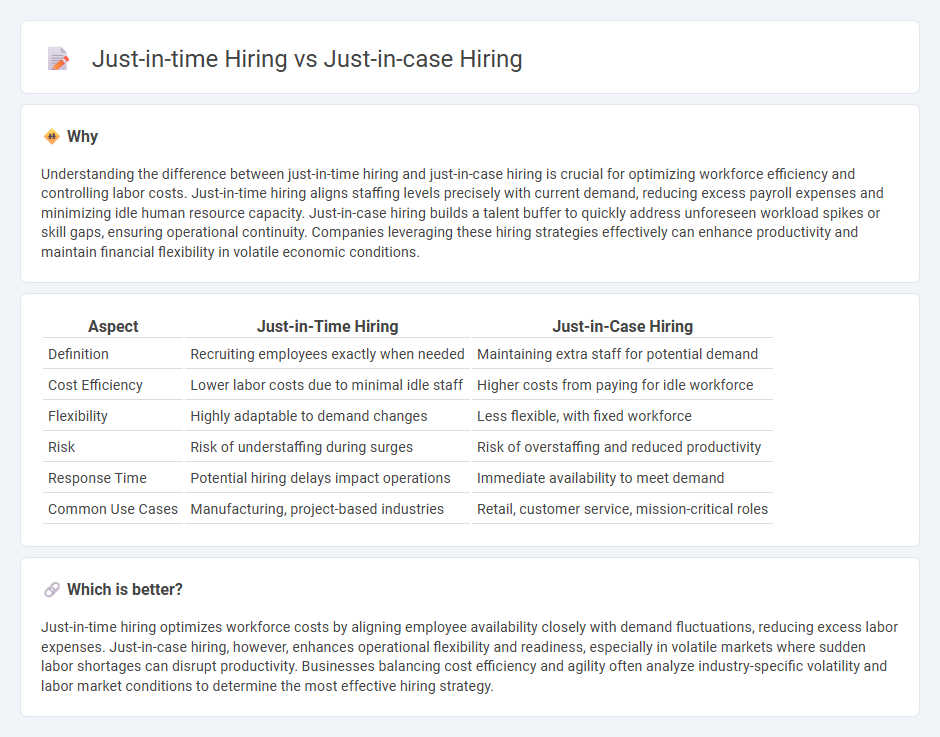
Just-in-time hiring focuses on aligning workforce needs precisely with current demand, minimizing labor costs and reducing idle employee time. In contrast, just-in-case hiring builds a larger workforce in anticipation of potential future demand, ensuring business resilience but increasing overhead expenses. Discover how these hiring strategies impact economic productivity and business agility.
Why it is important
Understanding the difference between just-in-time hiring and just-in-case hiring is crucial for optimizing workforce efficiency and controlling labor costs. Just-in-time hiring aligns staffing levels precisely with current demand, reducing excess payroll expenses and minimizing idle human resource capacity. Just-in-case hiring builds a talent buffer to quickly address unforeseen workload spikes or skill gaps, ensuring operational continuity. Companies leveraging these hiring strategies effectively can enhance productivity and maintain financial flexibility in volatile economic conditions.
Comparison Table
| Aspect | Just-in-Time Hiring | Just-in-Case Hiring |
|---|---|---|
| Definition | Recruiting employees exactly when needed | Maintaining extra staff for potential demand |
| Cost Efficiency | Lower labor costs due to minimal idle staff | Higher costs from paying for idle workforce |
| Flexibility | Highly adaptable to demand changes | Less flexible, with fixed workforce |
| Risk | Risk of understaffing during surges | Risk of overstaffing and reduced productivity |
| Response Time | Potential hiring delays impact operations | Immediate availability to meet demand |
| Common Use Cases | Manufacturing, project-based industries | Retail, customer service, mission-critical roles |
Which is better?
Just-in-time hiring optimizes workforce costs by aligning employee availability closely with demand fluctuations, reducing excess labor expenses. Just-in-case hiring, however, enhances operational flexibility and readiness, especially in volatile markets where sudden labor shortages can disrupt productivity. Businesses balancing cost efficiency and agility often analyze industry-specific volatility and labor market conditions to determine the most effective hiring strategy.
Connection
Just-in-time hiring focuses on recruiting employees precisely when demand arises, optimizing workforce costs and flexibility. Just-in-case hiring involves maintaining a talent pool in anticipation of future needs, ensuring readiness during demand spikes or economic fluctuations. Both strategies balance operational efficiency and risk management within dynamic labor markets.
Key Terms
Labor flexibility
Just-in-case hiring builds labor flexibility by maintaining a surplus workforce to address unexpected demand spikes, ensuring stability at the expense of higher labor costs and potential overstaffing. Just-in-time hiring enhances labor flexibility through precise, demand-driven recruitment, minimizing idle labor but requiring agile hiring processes and strong workforce analytics. Explore more about optimizing labor flexibility strategies to enhance operational efficiency and workforce management.
Inventory management
Just-in-case hiring mirrors inventory management by maintaining a surplus workforce ready to address sudden demand spikes, reducing risks but increasing labor costs, similar to stocking excess inventory for uncertainties. Conversely, just-in-time hiring aligns with lean inventory principles by recruiting precisely when needed, minimizing labor expenses but risking delays or shortages during unexpected demand surges. Explore how these hiring strategies impact operational efficiency and workforce agility.
Workforce planning
Just-in-case hiring involves maintaining a surplus workforce to prepare for potential demand fluctuations, ensuring business continuity but often leading to higher labor costs and resource underutilization. Just-in-time hiring focuses on aligning workforce acquisition precisely with immediate business needs, optimizing labor expenses and productivity while risking talent shortages during unexpected surges. Explore how strategic integration of these approaches can enhance workforce planning efficiency and adaptability in dynamic market conditions.
Source and External Links
Frequently Asked Questions - Employment - UC Berkeley - Discusses standard hiring processes, including internal-only recruitment review, but does not specifically define "just-in-case hiring."
Just in Case Careers and Employment | Indeed.com - Provides employee reviews and insights about a company named "Just in Case," unrelated to the hiring strategy term.
Job Opportunity to work with Just Case - Details job application process for Just Case USA Inc., an employer, without reference to the concept of just-in-case hiring.
 dowidth.com
dowidth.com